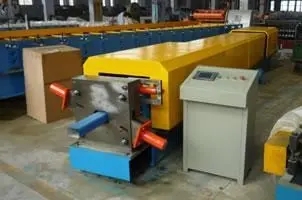
Understanding Strut Channel Roll Forming An Essential Process in Modern Manufacturing
In the realm of modern manufacturing, the roll forming process has emerged as a crucial technique for producing various metal profiles, with strut channels being one of the most commonly produced items. Strut channels are versatile components widely used in construction, HVAC systems, and solar panel mounting systems. Understanding the roll forming process for strut channels is essential for manufacturers and engineers alike, as it impacts not only the efficiency of production but also the quality and application of the end products.
What is Roll Forming?
Roll forming is a continuous bending operation in which a long strip of metal is passed through sequential pairs of rolls that progressively shape the metal into the desired cross-section. This method is particularly advantageous for producing lengthy, uniform shapes with high precision. Unlike other metal forming processes, roll forming is efficient for high-volume production and is capable of producing components with consistent tolerances and minimal scrap material.
The Process of Strut Channel Roll Forming
The roll forming process for strut channels typically involves several key steps
1. Material Selection The first step is choosing the appropriate metal, commonly galvanized steel, stainless steel, or aluminum, depending on the intended application and mechanical properties required.
2. Material Preparation The metal sheets or coils are prepared and fed into the roll forming machine. This stage may involve cutting the metal to the desired length and ensuring it is free of impurities that could affect the forming process.
3. Roll Design Custom-designed rolls are an essential aspect of the roll forming process. Each roll must precisely shape the metal as it passes through the machine. The design of the rolls dictates the final profile of the strut channel, ensuring that it meets specifications for strength and usability.
4. Roll Forming Process The metal feedstock is continuously fed through a series of rolls. Each pair of rollers gradually bends the metal until the desired strut channel profile emerges. This process requires careful calibration of the machinery to ensure consistent dimensions and structural integrity.

5. Cutting and Finishing After forming, the long strut channels are cut to the required lengths. Additionally, finishing operations may be performed, such as deburring, welding, or applying protective coatings to enhance durability and aesthetic appeal.
Advantages of Strut Channel Roll Forming
1. Efficiency Roll forming is capable of high-volume production with minimal waste, making it a cost-effective solution for manufacturers producing strut channels. The ability to produce long lengths of material also reduces the need for joints, enhancing structural integrity.
2. Precision and Consistency This method allows for precise control over tolerances, ensuring that each strut channel meets stringent specifications. Consistency is key in applications where safety and reliability are paramount.
3. Versatility Strut channels produced through roll forming are versatile and can be easily adapted for various applications. They can be integrated into different systems, including support structures for electrical components, plumbing, and industrial machinery.
4. Customization Manufacturers can design custom profiles tailored to specific requirements, ensuring that the end products meet the unique needs of their clients.
Applications of Strut Channels
Strut channels are used across various industries, including construction, aerospace, and automotive. They provide essential support structures in building frameworks, facilitate the installation of electrical conduits, and serve as mounting solutions in solar energy systems. Their flexibility and strength make them a preferred choice for engineers looking to create robust and reliable systems.
Conclusion
Strut channel roll forming represents a vital manufacturing process that contributes to the efficiency and effectiveness of numerous industries. By understanding the intricacies of this process, manufacturers can optimize production techniques, ensuring high-quality products that meet the evolving demands of the market. As industries continue to embrace innovation, the role of roll forming in producing essential components like strut channels cannot be overstated, paving the way for advancements in construction and beyond.